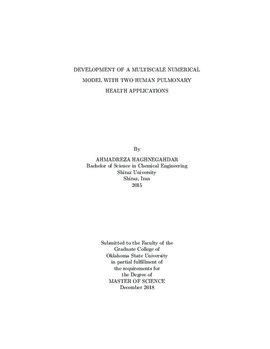| dc.description.abstract | Determination of the site-specific dosimetry and clearance of deposited aerosols in the human airways is critical in health risk assessment studies such as toxicant exposure evaluation and inhaled medication delivery with pulmonary topical or systemic actions. However, comprehensive evaluation still lacks informative data, i.e., high-resolution local dosimetry of inhaled aerosols in airways and systemic regions, due to the limited imaging resolutions, restricted operational flexibilities, and invasive nature of experimental and clinical examinations. Computational simulations, on the other hand, can provide a detailed explanation for the chemical dynamics in the respiratory system, intrapulmonary and extrapulmonary tissues, and systemic regions using multiscale platforms. In this study, two experimentally validated multiscale numerical analyses were developed for the post-deposition calculation of the respirable aerosols, which expands the application of mathematical models in the respiratory system to the health endpoint. First, computational fluid-particle dynamics (CFPD) is coupled with a physiologically based toxicokinetic (PBTK) model to predict the in tissue translocation and systemic disposition of inhaled volatile organic compound and toxicant constituents in an electronic cigarette (EC). The proposed framework can be used as a benchmark to identify drug or toxicant dynamics in the human body, significantly applicable in the fields of pharmacokinetics and toxicokinetics. Second, an epidemiological computational approach was programmed and optimized by connecting CFPD and host cell dynamics (HCD) models to simulate the transport and deposition of low-strain influenza A virus (IAV)-laden droplets in subject-specific human lung airways and to predict the regional responses of targeted host cells to IAV infection. Furthermore, the hygroscopic growth and shrinkage of multicomponent droplets were considered by examining the thermodynamic equilibrium between the phases. These frameworks overcome the limitation of the experimental studies by connecting levels of biological dynamics that are not measurable using clinical studies. The influence of repetitive exposure incidents on the post-deposition dynamics was determined, which is valuable for assessing the chronic health effects of inhaled airborne particles. | |
